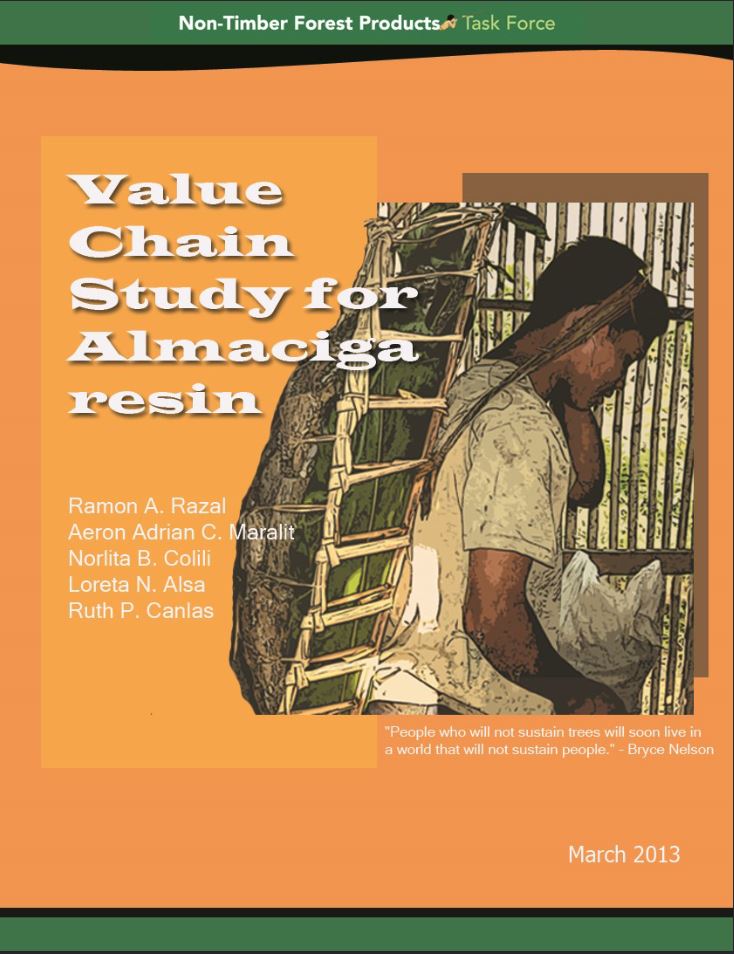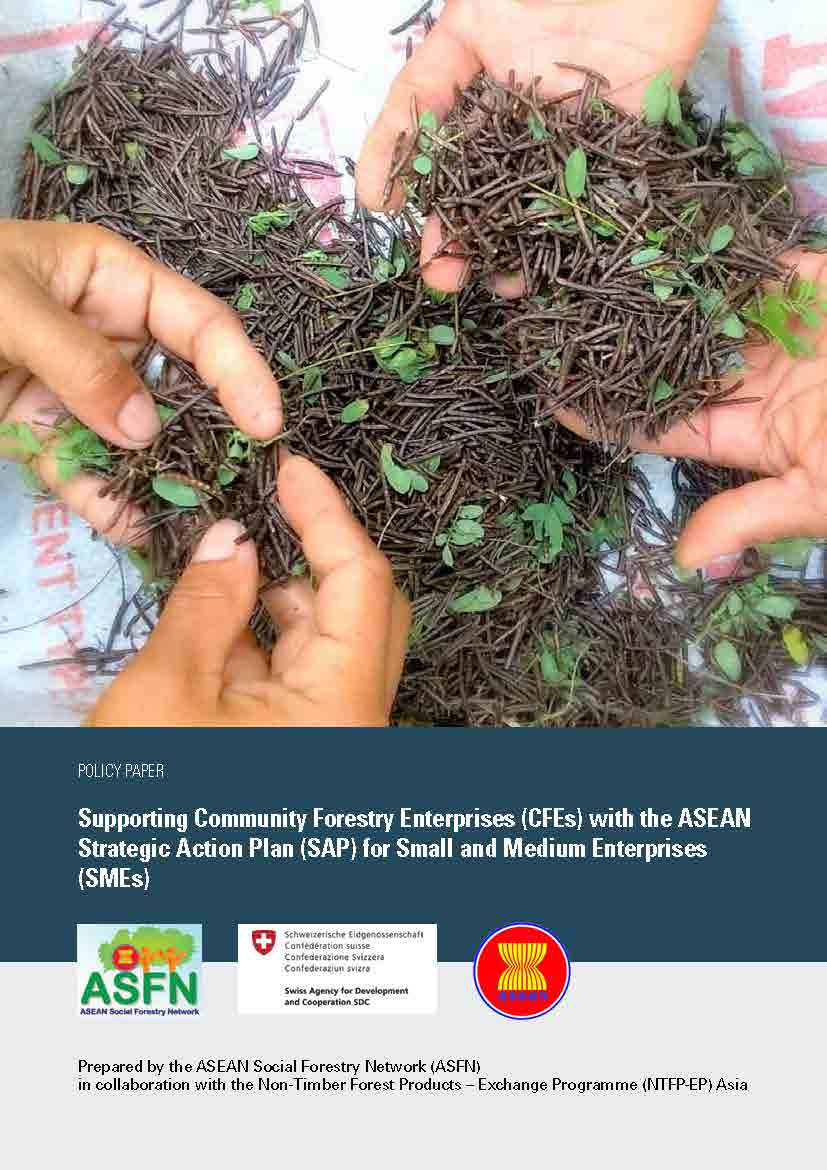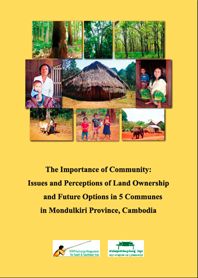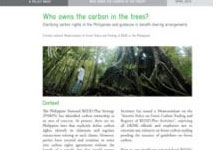This study was undertaken to elucidate on the almaciga resin value chain in Palawan and
serve as a basis for establishing an almaciga resin enterprise that can be managed by
the IPs specifically, NATRIPAL.
The main objective of the study is to explore the possibility of establishing a
community-based almaciga resin enterprise in Palawan. Specifically, the study aims to:
a) Determine the value chain for Almaciga resin production;
b) Assess the availability of Almaciga resin to sustain the requirements of a
processing plant; and
c) Assess the market for refined Almaciga resin.
Category: Papers
The Non-Timber Forest Products Exchange Programme (NTFP-EP) is a collaborative network of nongovernmental organizations (NGOs) and community-based organizations in South and Southeast Asia, working with forest-dependent communities to strengthen their capacity in sustainable management of these natural resources. The NTFP-EP was organized as a network to promote the use of non- timber forest products, with the fundamental purpose of protecting the forests. The forest is not just the trees but a conglomeration of many inter-dependent species of plants and animals, from the microscopic to the very large, which occupy an area together. The forest is more than the sum of its parts. There are several things that a forest accomplishes which cannot be done by anything else. They cannot even be done by the various forests species working separately. They are only done by a forest and that is why the forests must be protected (Rice, 2010).
The NTFP-EP believes that an effective way to protect and enrich the forests, and simultaneously fight poverty, is by helping forest dwellers make a good living from the forest itself by increasing the value of the various non-timber forest products (NTFPs). We define NTFPs as all biological materials from the forest that are extracted and consumed for human use (de Beer and McDermott, 1996). We believe that increasing the value of NTFPs might not be the only way to achieve the protection and enrichment of forests and at the same time to fight poverty, but it is certainly a good place to start. In brief, the NTFP-EP was founded on the goal to protect and improve the integrity of the forests and the livelihood and well-being of forest dwellers.
The World Bank reported that an estimated 90 percent of the poorest people rely on forests for subsistence and income. To date, forests are inhabited by approximately 1.3 billion rights holders of which 450 million people are living in the Asia-Pacific and an estimated 300 million people in the ASEAN region depend, directly or indirectly on the various benefits derived from its forests. These people and their communities can contribute to sustainable growth in the region if empowered through supportive policies and programs particularly on community economy, and assisted in developing sustainable forest and non-forest based livelihoods.
In January 2008, a team of researchers went to Mondulkiri province and conducted interviews of 237 households. The general purpose of the study was to investigate the situation of villagers living in fi ve communes, Bu Chrey, Krang Teh, Sokh Sant, O Buon Leu and Nang Khi Loek, with a particular focus on indigenous peoples in these communities.
In May 2008, the team returned to present their fi ndings and initial recommendations to selected individuals in the communities who had been previously interviewed. The team sought to validate their fi ndings, and solicit the opinions of the villagers on what steps need to be taken to assist them. The team also met with provincial authorities and NGOs in Mondulkiri.
The general conclusions of the study are:
• While a basic legal and policy framework exists for the protection of the rights of indigenous peoples in Cambodia, enforcement of laws remains weak, and the rights of indigenous peoples are not consistently protected and promoted. Continuing loss of indigenous lands has led to loss of livelihood and increasing poverty for indigenous communities.
• There is a general lack of clarity, fi rst, in how different laws interact with regard to indigenous land vis-à-vis economic land concessions, protected areas and forests, community forests and the like. Which laws take precedence? How do the relevant Ministries interact or cooperate? Second, borders are unclear. Some of the borders between communes, between the jurisdictions of Ministries, even between residences have not been plotted or defi ned. Third, there is no public information or consultation on concessions prior to their granting, so those affected are often the last to know about concessions that affect their land use. Last, procedures and regulations are not explained to villagers. The present confusing situation benefi ts those who are involved in land grabbing and speculation, as well as those requesting grants of concessions.
By Maia Diokno. Research Team: Research Team: Maia Diokno, Mey Sovannara, Ross Vanna, Van Virak.
This participatory research assessment is looking at better understanding the role of wild foods in the food security strategies of two villages of Ratanakiri province in order to develop innovative intervention to help communities to better adapt to current land use and climate changes. Workshops have been held before and after field data collection with the main local stakeholders and community members. Experiences, knowledge, ideas around the thematic of the research were discussed between the participants and the main results confirmed by local communities.
We are a growing ASEAN civil society community – now numbering 47 organizations who are active in 8 countries, Cambodia, Indonesia, Lao PDR, Malaysia, Myanmar, Philippines, Thailand and Vietnam. The Civil Society Forum is participated in by civil society and community based organizations (CSOs) and indigenous peoples network and membership organizations present in ASEAN who are all active in the forestry sector in the implementation of capacity building, awareness raising, and technical support in programs on forest and NTFP livelihood and marketing, forest rights and tenure, and traditional and indigenous knowledge systems on natural resources, and projects in REDD+ (Reducing Emissions from Deforestation and Forest Degradation Plus). The ASFN Civil Society Forum, established in 2012, is a platform to distill, consolidate and relay key messages from CSOs and communities to ASEAN member states via the ASEAN Social Forestry Network .
In the 3rd year gathering of the ASFN Civil Society Forum in Kota Kinabalu, Sabah, Malaysia on May 22-23, 2014, the CSO Forum affirmed that there has been progress made in more than the thirty (30) years of practice in social forestry particularly when under a framework of cooperation among forestry stakeholders that include local communities, particularly indigenous communities and other forest dependent groups and civil society organizations (such as non-government organizations, academe, and research institutions).
In particular, progress has been made in terms of the continuous roll out of improvements in community forestry through policy reviews and clarifications; the twinning or integration of community forestry with rural development and livelihood projects. In some countries, support by both civil society organizations and government to community forestry and producer groups have made possible linking them to traders, intermediaries and processors in order to improve access to markets and efficiency in the value chain; and linking community forestry to business development services and other financing schemes. Finally, national multistakeholder coordination or consultation bodies have been established in some countries for social forestry and climate change, particularly REDD+ with civil society and indigenous community representatives, for example, in Cambodia, Myanmar, Philippines and Vietnam.
Despite the significant progress, however, critical gaps still remain in the political will and commitment of Member States to realize long-term social forestry goals. Recently released assessment report on Social Forestry in climate change adaptation and mitigation in the ASEAN region by the Centre for People and Forests (RECOFTC 2014) noted that the deforestation rate still outpaces forest growth and national achievements on social forestry. Between 2010-2013, deforestation figures were at 13.3 million hectares compared to only 2.2. million hectares designated as community forests. The latter represents only 3.5% of forest area being managed by local people with official community forestry agreements. Some ASEAN countries demonstrate notable community forestry expansion within the last five (5) years such as Thailand (154%), Cambodia (62%), Philippines (38%) and Vietnam (15%) within the last five (5) years. However, the collective community forestry target within ASEAN at only 15.9 million hectares to a total remaining forest area of 434 million hectares (with forest cover decline at a rate of 6.3%) is not significant enough to generate maximum social and economic benefits for community economies that is consistent with ASEAN and its Member States’ sustainable development goals.
Under the auspices of the ASEAN-Swiss Partnership on Social Forestry and Climate Change (ASFCC), herewith we commit to engage with the ASFN towards the common objectives of:
- Developing and integrating social forestry approaches into the climate change adaptation and mitigation strategies of ASEAN and Member States, and
- Ensuring that socio-economic benefits are derived from the meaningful inclusion of the communities, women and vulnerable groups in social forestry and climate change adaptation and mitigation measures.
We are a growing ASEAN civil society community – now numbering 47 organizations who are active in 8 countries, Cambodia, Indonesia, Lao PDR, Malaysia, Myanmar, Philippines, Thailand and Vietnam. The Civil Society Forum is participated in by civil society and community based organizations (CSOs) and indigenous peoples network and membership organizations present in ASEAN who are all active in the forestry sector in the implementation of capacity building, awareness raising, and technical support in programs on forest and NTFP livelihood and marketing, forest rights and tenure, and traditional and indigenous knowledge systems on natural resources, and projects in REDD+ (Reducing Emissions from Deforestation and Forest Degradation Plus). The ASFN Civil Society Forum, established in 2012, is a platform to distill, consolidate and relay key messages from CSOs and communities to ASEAN member states via the ASEAN Social Forestry Network .
In the 3rd year gathering of the ASFN Civil Society Forum in Kota Kinabalu, Sabah, Malaysia on May 22-23, 2014, the CSO Forum affirmed that there has been progress made in more than the thirty (30) years of practice in social forestry particularly when under a framework of cooperation among forestry stakeholders that include local communities, particularly indigenous communities and other forest dependent groups and civil society organizations (such as non-government organizations, academe, and research institutions).
In particular, progress has been made in terms of the continuous roll out of improvements in community forestry through policy reviews and clarifications; the twinning or integration of community forestry with rural development and livelihood projects. In some countries, support by both civil society organizations and government to community forestry and producer groups have made possible linking them to traders, intermediaries and processors in order to improve access to markets and efficiency in the value chain; and linking community forestry to business development services and other financing schemes. Finally, national multistakeholder coordination or consultation bodies have been established in some countries for social forestry and climate change, particularly REDD+ with civil society and indigenous community representatives, for example, in Cambodia, Myanmar, Philippines and Vietnam.
Despite the significant progress, however, critical gaps still remain in the political will and commitment of Member States to realize long-term social forestry goals. Recently released assessment report on Social Forestry in climate change adaptation and mitigation in the ASEAN region by the Centre for People and Forests (RECOFTC 2014) noted that the deforestation rate still outpaces forest growth and national achievements on social forestry. Between 2010-2013, deforestation figures were at 13.3 million hectares compared to only 2.2. million hectares designated as community forests. The latter represents only 3.5% of forest area being managed by local people with official community forestry agreements. Some ASEAN countries demonstrate notable community forestry expansion within the last five (5) years such as Thailand (154%), Cambodia (62%), Philippines (38%) and Vietnam (15%) within the last five (5) years. However, the collective community forestry target within ASEAN at only 15.9 million hectares to a total remaining forest area of 434 million hectares (with forest cover decline at a rate of 6.3%) is not significant enough to generate maximum social and economic benefits for community economies that is consistent with ASEAN and its Member States’ sustainable development goals.
Under the auspices of the ASEAN-Swiss Partnership on Social Forestry and Climate Change (ASFCC), herewith we commit to engage with the ASFN towards the common objectives of:
(1) Developing and integrating social forestry approaches into the climate change adaptation and mitigation strategies of ASEAN and Member States and (2) Ensuring that socio-economic benefits are derived from the meaningful inclusion of the communities, women and vulnerable groups in social forestry and climate change adaptation and mitigation measures.






